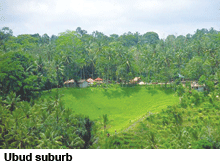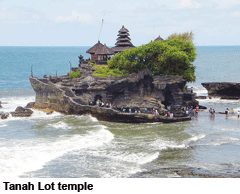Beyond the garish tourist hotspots of Muslim Indonesia’s Hindu majority island of Bali, there’s much which remains pristine and preserved, and Balinese Hinduism is still alive and thriving. Yoginder Sikand reports
 My flight descended through the purple-streaked evening sky, offering the extraordinary vista of an immense turquoise blue below, dotted with tiny, densely forested islands, marking our approach to Java. The plane taxied to a halt in Denpasar, the gateway to Bali. Giant Garuda statues ring the entrance of the airport, welcoming visitors to perhaps the only Hindu-majority province in Indonesia (pop. 237 million) which hosts the largest population of Muslims of any nation worldwide.
My flight descended through the purple-streaked evening sky, offering the extraordinary vista of an immense turquoise blue below, dotted with tiny, densely forested islands, marking our approach to Java. The plane taxied to a halt in Denpasar, the gateway to Bali. Giant Garuda statues ring the entrance of the airport, welcoming visitors to perhaps the only Hindu-majority province in Indonesia (pop. 237 million) which hosts the largest population of Muslims of any nation worldwide.
December-January is the peak tourist season and Bali is Indonesia’s lush and luxuriant paradise offering every opportunity for fun, rest and recreation. The highway from the airport into town is lined with rows of inns and hotels, body-piercing parlours, bars, discos and up-market boutiques flashing neon-lit signboards. Noisy Western music blared from loudspeakers, and scantily-dressed drunken Westerners, with heavily tattooed bodies and punk hairstyles, lounged around in droves.
I shuddered at the sight. A pair of half-naked Balinese women danced in the streets on stilts and beckoned tourists to buy tickets for what was advertised as a ‘sexy dance show’. The venue is a building erected on the very spot once occupied by a disco where, some years ago, radical Islamists set off bomb blasts killing several dozen foreign tourists. The sleaze and bustle before me bore no resemblance to the idyllic island of the popular imagination, which makes Bali so appealing to holiday makers.
I got off the taxi in the centre of town and slipped through a maze of alleys looking for lodgings. As I trudged ahead, I was accosted by local women at almost every corner cajoling me to engage their services for a ‘massage’. Some even handed out leaflets while touting for customers and whispering about other services they would willingly provide.
This is the deadly havoc that mass tourism, catering essentially to Western mania for Oriental exotica, has wrought upon Bali, as elsewhere in much of South-east Asia. The hunger for dollars — tourism is the mainstay of the Balinese economy — it’s clearly evident, has seriously undermined Bali’s much-vaunted cultural heritage, which is now a saleable commodity tailored to titillate western tourists. Yet, and despite this, there’s much of Bali which remains pristine and preserved, and Balinese Hinduism, the core of the country’s unique identity, is still alive and thriving.
I spent the night at the first inn I could get a room in, too tired to look for cheaper accommodation. The next morning I set about exploring Denpasar, beyond the quarter where most foreign tourists stayed. The town was cleaner and more prosperous than any other in Indonesia I had visited, and people were friendly and hospitable. Every home, I noticed, hosted a little temple, or a pura in Balinese, located in the courtyard or garden.
 Larger temples graced every street, amazing works of art, based on a standardised design and primarily constructed from grey stone and red brick. Their entrances were guarded by stone-carved dwarf keepers with bulging eyes and bared fangs, and pot-bellied Kuberas. The walls were richly rendered with friezes depicting scenes from the Ramayana and Mahabharata, and carvings of snakes and dragons. Embellished statues of Hindu deities dotted the interiors, and reliefs of multi-limbed asuras and animals, swarmed over the surfaces. Denpasar’s crowning architectural marvel is the imposing Jaganath Pura temple, built around a massive lingam-shaped tower, surro-unded by fish pools and trees laden with orchids.
Larger temples graced every street, amazing works of art, based on a standardised design and primarily constructed from grey stone and red brick. Their entrances were guarded by stone-carved dwarf keepers with bulging eyes and bared fangs, and pot-bellied Kuberas. The walls were richly rendered with friezes depicting scenes from the Ramayana and Mahabharata, and carvings of snakes and dragons. Embellished statues of Hindu deities dotted the interiors, and reliefs of multi-limbed asuras and animals, swarmed over the surfaces. Denpasar’s crowning architectural marvel is the imposing Jaganath Pura temple, built around a massive lingam-shaped tower, surro-unded by fish pools and trees laden with orchids.
Shaivism is the main sect of Hinduism in Bali, and so most temples are dedicated to Shiva, although the Balinese worship other Hindu deities too, and the Buddha in addition to ancestral spirits. Even in the early morning hours, the temples are packed with worshippers. Rows of women, dressed in batik sarongs and tight-fitting white lace coats, with colourful flowers tucked behind their ears, and bronzed men with batik turbans and sashes wound round their waists, carry little baskets of bamboo leaves as they go about their worship. The baskets laden with votive offerings — flowers, ince-nse sticks, biscuits, rice and cigarettes — are placed before decorated stone towers shaded under silk umbrellas.
An elaborate puja was being performed by priests (referred to as panditas in Balinese). The practice of Balinese Hinduism, is as much a fine art as it is worship, and is invested with a beauty, grace and softness which I couldn’t help comparing favourably with noisy Hindu practices back home. It was also more ceremonial and ritualistic. This, and the fact that Hinduism as practised in Bali is casteist, was the major reason why, over the centuries, Hindus in Indonesia mass-converted to Islam.
An hour’s drive from Denpasar is Ubud (pop. 30,000), a tourist hotspot which was once the seat of a major Balinese dynasty, and still preserves many of its ancient traditions. There are dozens of temples, amazingly beautiful, and a sprawling palace is still occupied by members of the erstwhile royal family. In the centre of town there is a convergence of shops and boutiques selling fine Balinese handicrafts — carved furniture, paintings, masks and Buddha heads, bundles of batik cloth and the like, and a string of pricey restaurants which inter alia serve cobra, python and crocodile meat.
 I followed the beaten tourist trail in Ubud but broke off after a while to scout around the low-lying hills beyond the town. They are carpeted with parrot-green paddy fields and orchards thick with coconut, tapioca and beetle-nut trees surrounding neat wooden bungalows. Village children raced about sailing enormous kites shaped like Garudas, dragons, snakes and giant fish with long tails. Men and women wearing straw hats worked the fields. On learning that I was from India, their faces lit up. “Om Swastyastu!” they greeted me in traditional Balinese style. “Bali-India sama-sama!” (Bali-Indian are the same) they exclaimed, delighted to meet a visitor from Hindu India, while I diplomatically refrained from informing them that the mother country, with all its horrors, can hardly be compared to their idyllic little island.
I followed the beaten tourist trail in Ubud but broke off after a while to scout around the low-lying hills beyond the town. They are carpeted with parrot-green paddy fields and orchards thick with coconut, tapioca and beetle-nut trees surrounding neat wooden bungalows. Village children raced about sailing enormous kites shaped like Garudas, dragons, snakes and giant fish with long tails. Men and women wearing straw hats worked the fields. On learning that I was from India, their faces lit up. “Om Swastyastu!” they greeted me in traditional Balinese style. “Bali-India sama-sama!” (Bali-Indian are the same) they exclaimed, delighted to meet a visitor from Hindu India, while I diplomatically refrained from informing them that the mother country, with all its horrors, can hardly be compared to their idyllic little island.
Classical Hindu epics — the Ramayana and Mahabharata — are perhaps as much venerated in Bali as they are in India, and seem to be more integrated with people’s lives in this Hindu-majority island. Almost every night, a professional troupe stages a dance and theatrical performance based on the Ramayana, which is as much a form of worship as it is entertainment, and a visual treat no visitor should miss. The performance I went to began with a puja, led by a Brahmin priest and his wife, who went around the crowd pouring holy water into people’s outstretched palms. Set to the haunting music of the gamelan, a traditional Balinese orchestra, the dance drama was colourful and captivating. It ended with the sanghyang diran or fire dance, in which an actor dressed as a horse, repeatedly leapt upon a massive heap of burning coconut shells. He seemed to be in a deep trance through the performance, at the end of which he slowly revived after the presiding priest splashed holy water on him, and intoned a mantra.
Beyond Ubud as well, the countryside abounds in towns and villages certain to charm off-the-beaten-track visitors. Destinations worth exploring are the Goah Gaja cave, its mouth carved in the form of an enormous, fierce-looking asura, which contains a rich assortment of Hindu and Buddhist statues. Within walking distance is the massive Tampak Siring temple complex, comprising numerous small shrines and sacred ponds fed with water flowing down from the thickly-forested volcanic peaks nearby.
Further, and up in the mountains, one traverses through neat cacao, coffee and vanilla plantations to arrive at Besakhi, widely acclaimed as Bali’s ‘mother temple’, and certainly among the largest temple shrines in the world. This majestic complex covers the entire face of a tall mountain, from base to summit, and comprises hundreds of temples of varying sizes, little pavilions and goldfish pools. It was raining torrentially on the day I visited Besakhi. Nevertheless the shrine was teeming with worshippers gathered in a central square half way up the mountain, before a giant stone throne symbolising Lord Shiva’s seat, with a duo of priests conducting an elaborate ceremony.
 As I wandered through the complex I entered another shrine, where a friendly priest drew me to the front of the assembly. “It’s the dream of every Balinese Hindu to visit Varanasi and the source of the Ganga. These places must all be so beautiful,” he said wistfully. I didn’t have the heart to update him about the Ganges, one of the most polluted rivers in the world.
As I wandered through the complex I entered another shrine, where a friendly priest drew me to the front of the assembly. “It’s the dream of every Balinese Hindu to visit Varanasi and the source of the Ganga. These places must all be so beautiful,” he said wistfully. I didn’t have the heart to update him about the Ganges, one of the most polluted rivers in the world.
From Besakhi, a quick round of several neighbouring towns is mand-atory. Khung Kung, dominated by a palace of the local raja; Mengui, awesome for its royal temple; and Tanah Lot, striking for its mushroom-shaped temples built on gigantic volcanic rocks jutting into the sea, and a spring that gushes forth from the mouth of a three-headed rock cobra.
In just about a week I had coursed through the cultural landscape and major sites of Bali. There was more to see and much to learn, but my time was short. And so, sad of heart, but the spirit willing to return some day to round off my exploration of what in my view is among the top 5 places one should visit in one’s lifetime, I took my leave of a society in which a syncretic culture and the essence of Hinduism is well honoured and preserved.